No Time to Lose: A Timely Guide to the Way of the Bodhisattva
Pema Chodron
Shambhala Publications 2005
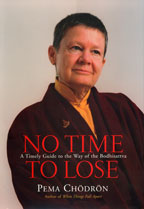 Buddhism has always struck me as a fine balance between high ideals and common sense. The former gives us something to aim for, whereas the latter delivers practical advice to lead us out of our suffering. In Pema Chodron’s latest book, No Time to Lose, the American Buddhist nun provides both by offering her commentary on The Way of the Boddhisattva, an eighth-century Buddhist poem by the upstart monk Shantideva, who presented it to his fellow monks before wandering away from the university.
Buddhism has always struck me as a fine balance between high ideals and common sense. The former gives us something to aim for, whereas the latter delivers practical advice to lead us out of our suffering. In Pema Chodron’s latest book, No Time to Lose, the American Buddhist nun provides both by offering her commentary on The Way of the Boddhisattva, an eighth-century Buddhist poem by the upstart monk Shantideva, who presented it to his fellow monks before wandering away from the university.
Reading Shantideva’s poem, it is obvious that not much has changed for humankind in 1300 years. We are still greedy, self-absorbed and ruled by our desires and kleshas, negative emotions that distort our perception and keep us from experiencing the present moment. In our search for happiness, we repeatedly reach for and attach ourselves to things that are impermanent, destined to disappear and die, including our ego.
Death, indeed, looms large throughout the book. Leading a life full of compassion and free of attachment assures an easier passage when our end comes. “If we can’t handle being told off or not getting what we want, how will we be able to handle death?” Chodron asks almost urgently. And as we have no idea when this might occur, there is no time to lose in getting our house, and more importantly, our heart in order.
Using vivid imagery and written in very accessible language, the poem itself provides a systematic, if somewhat idealistic, program for achieving happiness, good karma and peace of mind throughout our lives and at the end. Chodron’s interpretation, in gentle and engaging prose, shows us how Shantideva’s advice and admonitions apply to our daily trials and tribulations.
Of course, there is a difference between ideals and what we can realistically achieve. Meditating upon the dirtiness and eventual decay of the human body in order to quell lust, for instance, is a hard sell for both Shantideva and the wise and modern Chodron. Most of us, after all, are neither monks nor nuns. It is definitely something to ponder, however, when possessed by one of our most human and perhaps destructive kleshas.
The philosophy and the teachings in No Time to Lose are similar to those found in other books by Chodron or other Buddhist writers: The mind causes our unhappiness, thus we must learn to apply mindfulness to all our actions and interactions; generosity is its own reward; and all hardships in life are opportunities to learn, to free ourselves from self-absorption, to practise the virtue of patience. What is different here is the logical build-up of the teachings: from developing our intention to change, to preparing the groundwork and transcending our hesitation, all the way through taming the mind and dissolving the barriers between self and other.
Reading this book from beginning to end feels like walking the Boddhisattva’s path. Though we may not be enlightened when we reach the final page, Shantideva and Chodron have provided us with a practical guide should we wish to embark on the real journey.
– Tess Fragoulis
back to top
Hatha Yoga: The Hidden Language
by Swami Sivananda Radha
timeless books 2006
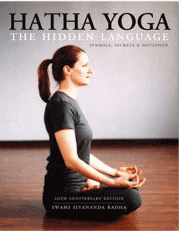 Sometimes my body feels like it’s speaking in tongues. That tight shoulder, the pain in my lower back – what does it mean? What is my body trying to tell me? Originally published in 1988, Hatha Yoga: The Hidden Language details Swami Radha’s systematic approach to understanding the symbolism of the asanas and messages from the body.
Sometimes my body feels like it’s speaking in tongues. That tight shoulder, the pain in my lower back – what does it mean? What is my body trying to tell me? Originally published in 1988, Hatha Yoga: The Hidden Language details Swami Radha’s systematic approach to understanding the symbolism of the asanas and messages from the body.
I first encountered Hidden Language a couple of years ago during a morning Hatha Yoga class at an ashram. I was surprised when the instructor asked us to pull out our journals and write words we associate with trees before we lifted into the Tree pose. We came out of the pose and reflected further on the tree as a symbol, and then the instructor posed questions: Where are your roots? What nourishes you? We went into the pose again, reflecting on the questions and being receptive to insights. It seemed so mysterious and yet obvious: Hatha Yoga asanas are based on real, tangible things – trees, flowers, birds, structures. Of course these physical forms have the potential to function as metaphors as well.
“Hidden Language Hatha Yoga is both deeply personal and brilliantly universal,” writes ascent columnist Swami Lalitananda in her introduction to the new edition. “Through attention to the symbolism of the asanas, we can discover layers of meaning and make connections that change our lives. Because we are listening to the body, our reflections take on an honesty and reality that the mind can’t deny.”
After that initial class, I bought the Hidden Language book and have worked with it on a regular basis. The questions and reflections on the poses have helped me translate the discordant dialogue between my body and mind. My copy of the book is dog-eared and covered in notes – this new edition is to be released just in time.
It’s difficult to make a good thing better, but this new edition is a vast improvement on the original. Much remains the same: each chapter is a different asana, with twenty-two altogether – basics such as Tadasana (the mountain), Matsyasana (the fish) and Garudasana (the eagle) – and they are presented in the same order.
There are some new additions as well. The line drawings have been replaced by the artful photography of Derek Shapton. This is not to say that the changes are merely cosmetic – the new edition is much more user-friendly. The bibliography is updated and appendices on mantra, Kundalini Yoga and other spiritual practices have been added.
I am still trying to decipher the secret code of my body, and Hatha Yoga: The Hidden Language is an excellent guide. This book will satisfy long-time practitioners of Hidden Language Hatha Yoga and introduce a new generation of yogis to a brilliant approach to the deeper meaning and full potential of Hatha Yoga.
– Roseanne Harvey
back to top
Race Against Time
by Stephen Lewis
House of Anansi Press 2005
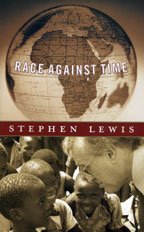 Race Against Time is the published version of the 2005 Massey Lectures, a five-part series delivered by Stephen Lewis and broadcast by the CBC in November 2005. Lewis, the UN special envoy for HIV/AIDS in Africa and one of Time magazine’s 100 most influential people of 2005, does not mince his words: the current situation in Africa is comparable to the Holocaust, and it is immoral for anyone, from you or me straight to the top of every government and international body, to be silent in the face of such tragedy.
Race Against Time is the published version of the 2005 Massey Lectures, a five-part series delivered by Stephen Lewis and broadcast by the CBC in November 2005. Lewis, the UN special envoy for HIV/AIDS in Africa and one of Time magazine’s 100 most influential people of 2005, does not mince his words: the current situation in Africa is comparable to the Holocaust, and it is immoral for anyone, from you or me straight to the top of every government and international body, to be silent in the face of such tragedy.
Not very diplomatic for a diplomat. It is more than clear what a risk it was for Lewis to deliver these lectures, and he acknowledges as much. No one is safe from his criticism, not even himself. In essence, he depicts both the United Nations family of organizations and the leadership of most industrialized countries as untruthful and ineffectual hypocrites when it comes to human rights in Africa. Quite simply, I’m amazed he still has his job, and I fluctuate between being inspired by his fearlessness, delighted at his straight talking and worried for his future. And yet, even at his most cutting, Lewis makes clear his unfailing and constructive commitment to actively making things better.
These lectures, which cover everything from debt to trade to education to gender as they relate to Africa and AIDS, are a must read for everyone. Better yet, get yourself a copy of the CD version (Lewis himself acknowledges that his true vocation is the spoken word) and hear the master orator at work. The most powerful of the lectures capture the profound humanity of what is happening in Africa, and jarred me out of a comfortable slumber from which the crisis can seem so immense and far off that it is difficult to engage on more than an intellectual level. Wide awake, I was in awe of his ability to lead me through the most complex and profoundly distressing issues while keeping both my emotional connection and hope alive.
The points at which his focus tends to move away from the humanity of the crisis and towards its macro-organizational aspects are where his words lost some of their power for me. And on finishing the final lecture, entitled “Solutions: A Gallery of Alternatives in Good Faith,” I couldn’t help wishing he’d thrown a bit of activism for the individual citizen into his direct calls for national and international reform and accountability. But I can’t be too hard on the guy. After all, he is a hero in the truest sense of the word, and his principled courage is an example to all of us.
– Nikko Snyder
back to top
What the Stones Remember: A Life Rediscovered
by Patrick Lane
Shambhala Publications 2005
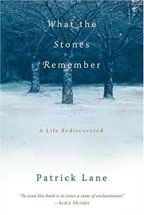 This memoir by one of Canada’s best-known poets follows Patrick Lane’s first year of recovery from a lifetime of alcoholism, a recovery that unfolds almost entirely in his Vancouver Island garden. The narrative weaves between his present-tense garden and the struggle and brutality that was Lane’s past. His poetic voice permeates his storytelling, compelling us to see how the honesty and enchantment of the natural world can save us from our nightmares, our addictions, our terrible losses – if only we will let it.
This memoir by one of Canada’s best-known poets follows Patrick Lane’s first year of recovery from a lifetime of alcoholism, a recovery that unfolds almost entirely in his Vancouver Island garden. The narrative weaves between his present-tense garden and the struggle and brutality that was Lane’s past. His poetic voice permeates his storytelling, compelling us to see how the honesty and enchantment of the natural world can save us from our nightmares, our addictions, our terrible losses – if only we will let it.
Originally published a year and a half ago in Canada as There Is a Season: A Memoir in a Garden, the book won the 2005 BC Award for Canadian nonfiction. It is not at all disingenuous for Lane to re-release his memoir under a new title – What the Stones Remember – as there really are two stories folded into the one book. This new title summons the story of Lane’s turbulent past as a wayward child, an absentee father, a fledgling poet, a failed husband, a triumphant writer, and ultimately a recovering addict. We follow him deep into his personal history and come to understand, along with him, that it is a miracle he is still alive. This story is rich with personal intrigue, gossip, sentimentality and curiosity. I think it’s rare that we look even into our own lives so intimately.
The second story is the simple unfolding of the seasons in his suburban garden, and it mirrors Lane’s journey of recovery and self-redemption. His garden is his sanctuary and the midwife of his rebirth as a sane and sober person. He delves into the ecology of his garden with the same studied depth as he digs through his personal history. The carefully documented hours of observation are underscored by a book knowledge of plant and animal classification, behaviour and habitat.
This being said, Lane is first and foremost a poet, and his garden ramblings are never dry or dense. How can they be when he periodically unearths old vodka bottles in the woodpile or under a bush? Or when he stops to watch a hermit thrush dance and mourn beside its dead mate? Or sees his mother, long decades dead, kneeling in the corner under the plum tree?
What the Stones Remember contains equal parts beauty and horror. Patrick Lane describes a past that many people would be inclined to leave buried in the furrows of time. But in bringing forth the dead, the wounded, the lost, this poet carves a path of healing and new life.
– Lesley Marian Neilson
back to top
Weight
by Jeanette Winterson
Alfred A. Knopf Canada 2005
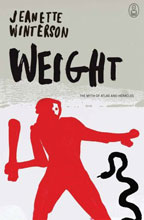 I’ve always been perplexed by the endless array of Greek gods and goddesses, who seem inaccessible and distant from my experience. But I was happy to pick up Jeanette Winterson’s Weight, a retelling of the myth of Atlas – the “long suffering one” who carries the Earth and the Heavens on his shoulders.
I’ve always been perplexed by the endless array of Greek gods and goddesses, who seem inaccessible and distant from my experience. But I was happy to pick up Jeanette Winterson’s Weight, a retelling of the myth of Atlas – the “long suffering one” who carries the Earth and the Heavens on his shoulders.
Winterson provides a way into the myth that is both personal and universal. She tells us she never knew her biological parents and was rejected by her adoptive mother. Like all of us, she had little choice about the world she was born into; however, through pain and practice over time she let down the burdens of broken family and unrealized desires. She reflects, “Having brought no world with me, I made one … it’s on my back now, vast and expanding. I hardly recognize it. I love it. I hate it. It’s not me, it’s itself. Where am I in the world I have made?”
Winterson creates interesting characters out of the ancient gods and goddesses, making for compelling reading regardless of your familiarity with the myth. Atlas was punished by Zeus and obligated to support the weight of the Earth and Heavens. He was temporarily relieved of this burden by Heracles (the hero), who needed the Titan’s aid in procuring the Golden Apples from a garden to which Atlas had access. Heracles shoulders the Earth and Heavens while Atlas seeks the apples. Atlas was successful and returned quickly enough, but in the meantime Atlas realized how pleasant it was not to have to strain for eternity keeping Heaven and Earth apart. So he told Heracles that he’d have to fill in for him for a while. Heracles, portrayed by Winterson as a womanizing thug, agrees but tricks Atlas by asking him to hold the Earth for a moment while he gets a cushion for his shoulder. Atlas falls for this and ends up holding the Earth and Heavens apart for eternity. Well, almost eternity – Winterson throws a curve ball into the myth as she propels us from ancient Greece to the space age as Laika, the little dog the Russians blasted into space in 1957, becomes Atlas’ best friend. With Laika on his shoulder, Atlas knew he was carrying something he wanted to keep. Laika informs Atlas of the world she knew and soon a strange thought enters his mind: “Why not put it down?”
This book is beautifully balanced and full of timeless questions. You could easily carry it on your shoulder but I suggest you put it in your hands and read it. Weighing in at just 370 grams, it’s a light read worth weeks of weightless pondering.
– James Gates
back to top
The Journey from the Center to the Page: Yoga Philosophies and Practices as Muse for Authentic Writing
by Jeff Davis
Gotham Books (Penguin) 2005
 In recent years, I have realized writing is a physical practice with body and breath awareness conducive to accessing and integrating our story. As a writer with an irregular yoga practice, I was therefore very grateful to discover Jeff Davis’ The Journey from the Center to the Page.
In recent years, I have realized writing is a physical practice with body and breath awareness conducive to accessing and integrating our story. As a writer with an irregular yoga practice, I was therefore very grateful to discover Jeff Davis’ The Journey from the Center to the Page.
As Davis puts it, tools such as concentration (dharana), meditation (dhyana), visualization (bhavana) and self-study (svahyaya) are not an end in themselves. They give shape to our lives and help us live in the world. Each chapter ends with breath awareness (pranayama) and physical postures (asanas), illustrating how our breath and body can also be the muses that help us navigate the craft of narrative, whether it is fiction, nonfiction or poetry.
“When you write from the center, you write what your spirit, body, and language demand you write,” Davis says in his introduction. Such a practice will “shake you out of your comfortable” habits and take you into some dark territory. What this book helps you to do is access your own inner resources of courage and confidence to descend into that dark center and emerge, ready to face your authentic self on the page.
The book begins generally with preparations for the writing journey and gets more specific with chapters such as “The Art of Wandering in First Drafts.” Davis advises us to begin writing with a two-part intention. First ask, “What am I writing for?” Secondly, clarify a more immediate focus for writing on a particular day.
The Journey from the Center to the Page also affirms the writing life – that in our solitude we may know others have also experienced the exaltation and the disappointment. The “emotional crags” are also covered in “Facing Fear” and “Writing Based on Your Self.” I was further impressed with Davis’ many references to other writers as mentors and examples of those who have written with wonder and an awakened imagination.
As I neared the end of the book, I thought, “Isn’t yoga – and the exploratory nature of writing – about letting go of expectations?” He covers this as well in his chapter “For Writers Who Already Practice Yoga,” telling us to “get to the mat just to see what happens or doesn’t happen.” The same can be said for the page.
There is so much good information in this book that I want it to be spread out in a spiral-bound workbook, opened flat beside me, rather than be compacted like a novel. In The Journey from the Center to the Page, yogis may find a desire to write and writers will find support for turning their sedentary, often lonely, vocation, into an embodied and dynamic practice.
– Mary Ann Moore
back to top
The Unfolding of Language: An Evolutionary Tour of Mankind’s Greatest Invention
by Guy Deutscher
Metropolitan Books 2005
 From a yogic perspective, the basic trinity is body, mind and speech. Speech? For most of us in the West, this seems rather odd, somewhat out of place. But is it? Here is a book to find out.
From a yogic perspective, the basic trinity is body, mind and speech. Speech? For most of us in the West, this seems rather odd, somewhat out of place. But is it? Here is a book to find out.
As the subtitle promises, Guy Deutscher, a mathematician with a Ph.D. in linguistics, presents a sweeping exploration of our greatest invention as a species. But from page one to the end, he shows that, in fact, language was never actually invented. This apparent paradox, he says, is at the core of our fascination with language, and holds many of its secrets.
This book is written as a mystery tour. With an expert’s analytical skills and a storyteller’s warmth and wit, Deutscher unravels language clues evident from the smallest of fragments left from the beginnings of history to the common street jargon of today. He weaves the evidence together to show how a relentless process of destruction and creation shapes and forms the spoken and written word. In the process, he incorporates some surprising elements. One, for me, was the chapter “A Reef of Dead Metaphors,” where he shows how these linguistic embellishments, long after they have lost their lofty place as creative expressions, become the ordinary foundation blocks in very ordinary language.
However absorbing and fascinating the story, there are parts in The Unfolding of Language that present a stiff challenge. With compassion for readers with limited linguistic stamina, Deutscher signals these sections in advance, suggesting, in one case, a strong cup of coffee and in another (perhaps for those with more particular diets) the simple option of skipping to the next chapter. I qualified for either option, but by those points in the book I was hooked and kept on, which is surprising. I even ignored his warning that these parts were not for bedtime reading.
Somehow, Deutscher had all but vanquished what remained of ghosts from my grade-school grammar and spelling traumas. How often had I run the gauntlet of these spooks in what seemed to be a never-ending lineup of mind-numbing rules, classifications and dissections? Guy Deutscher wasn’t even born when I needed him most. But here he is today with this extraordinarily interesting book.
The Unfolding of Language provides convincing evidence that the ancients from the East had it right – speech is part of our ruling triumvirate. And yes, the power of speech can quite appropriately be symbolized as a goddess, the Devi. Perhaps without knowing it, Guy Deutscher has declared himself one of her most eloquent devotees in the West. This book is spreading the word.
– Swami Sivananda
back to top
 Somalia’s rivers of violence have not drowned the raw poetic voice of K’naan. Embittered by the tragedy of his war-torn homeland, K’naan rises from the rubble of refugee camps, prison, and a civilization crushed under gang warfare with a debut rap album about struggle and freedom.
Somalia’s rivers of violence have not drowned the raw poetic voice of K’naan. Embittered by the tragedy of his war-torn homeland, K’naan rises from the rubble of refugee camps, prison, and a civilization crushed under gang warfare with a debut rap album about struggle and freedom.
Entitled The Dusty Foot Philosopher, this album records K’naan’s own struggles through isolation, the destruction of a homeland, and the dignity he seeks. Despite it all, he sings out his pain. Deeply influenced by his heritage of poets, K’naan brings this lyrical sensibility into the realm of rap, to recount the myths, realities and hardship of his people. Rap, he claims, is the poor peoples’ weapon, the voice of the unheard.
“I know struggle, and struggle knows me.” His relationship to struggle is developed in each track of the album. Starting with birth, where he claims Satan stabs a child in order to introduce pain, he goes on to explain a childhood cut short by grenades, an adolescence holding an AK-47, and an adulthood of poverty and isolation. Down to the colour of vomit and blood, his songs describe present-day Somalia’s stark reality. K’naan’s depiction of his childhood is graphic, and disturbing. This is no World Vision commercial break. This is blatant random rape and ceaseless violence.
His philosophy is deeply informed by pain. Pain of violence, and the burden of anonymity. Asking, “How could rap quench my thirst?” he speaks from the frustrated voice of an unrecorded artist. The depth of one man’s pain speaks to my own struggle. Though I have not known war, I have known the betrayal of isolation, the unquenched yearning for a sense of place; I have lived with the burning desire to be heard.
Testing the limits of the genre, K’naan includes a roundtable of voices, trill of female vocals, interludes of guitar; oud and djembe are synchronized with techno tracks reminiscent of Eminem. K’naan’s lyrics are seamless. Poetry is the language he speaks. Pushing the breaks in line, his pauses are like well-timed cuts and jabs that knock your feet into sync. Clenched jaw and tight fists, his songs are a call to action and a plea for the freedom from pain; freedom for his people.
My conundrum with rap is the danceability of the beats in contrast to the oppressive language it clings to for expression. "Oppressive", "misogynist", and "violent" are but a few terms that fall from my tongue when I think of rap. My mind turns to my feet and commands them to stop dancing. But K’naan’s is blues rap, speaking to the sorrow of a soul. Struggle becomes his muse, suffering his companion. Desperate and vulnerable, this solo act reveals a man who has talent to match his courage.
– Anne Read
back to top
In the Heart of the Moon
Ali Farke Touré & Toumani Diabaté
Nonesuch 2005
| click here to listen |  |
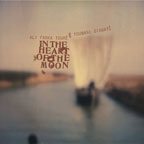 A gently entrancing dance of two beautifully focused and masterful artists, from its first chords In The Heart of the Moon is irresistible. Modest, never showy, these two deservedly celebrated musicians engage in a hypnotically rhythmic interplay of two distinct but highly compatible instrumental voices. Fans of the hit album Talking Timbuktu, with the late Ali Farke Touré and Ry Cooder, may be hoping for stronger blues riffs, and could be prone at first to mild disappointment with this subtler pairing. One needs to give the deceptively simple repetitive patterns time to build, weave their spell, and enthrall you with a trance effect that is at the heart of traditional African music.
A gently entrancing dance of two beautifully focused and masterful artists, from its first chords In The Heart of the Moon is irresistible. Modest, never showy, these two deservedly celebrated musicians engage in a hypnotically rhythmic interplay of two distinct but highly compatible instrumental voices. Fans of the hit album Talking Timbuktu, with the late Ali Farke Touré and Ry Cooder, may be hoping for stronger blues riffs, and could be prone at first to mild disappointment with this subtler pairing. One needs to give the deceptively simple repetitive patterns time to build, weave their spell, and enthrall you with a trance effect that is at the heart of traditional African music.
I imagine these two fine string players sitting out under a tree in a village square on a hot afternoon, playing… just playing, and listening intently to one another with a kind of reverent joy. Occasionally I hear an exclamation from one in Malian dialect or a few phrases sung, spontaneous moments that are the more precious for their rarity. A smattering of applause at the end of one number reflects the intimacy and immediacy of audience.
The album was actually recorded in a hotel room in the heart of Mali’s capital city, Bamako, overlooking a river dotted with fishing boats. In three two-hour sessions the album was complete, every song recorded in a single take. Remarkably, this is the first time Farke Touré and Diabaté have played together. Yet Farke Touré’s guitar and Diabaté’s twelve-string traditional kora come together in a union meant to be, as if they’d always known one another. One will hold down a bass line, and with a nod let the other take off on an improvised solo. Then at a mutually intuited moment, the other will take over the sinuous lead line. Nick Gold, the American record producer who initiated the project, said that at the end of each song he realized he’d been holding his breath through the recording – the music was so hypnotizing.
Clearly Farke Touré and Diabaté have profound respect for one another. In the touchingly poetic album notes, Farke Touré reveals that they are from different tribes and different musical traditions in Mali. And while customarily it’s rare for two players to perform together in this way, they did so with no borders, no competition, bringing to life a repertoire of songs from the 1950s and ’60s with no rehearsal. Diabaté calls Farke Touré the “lion of the desert,” the “prophet of the blues,” and marvels that he could so effortlessly flow into music not of his own tradition. He says he first heard Farke Touré on Radio Mali when he was a child, and felt his music was strange, but great. For his part, Farke Touré calls Diabaté “a child who was born in my hands.” Such is the magic of their music. Perhaps that birthplace was in the heart of the moon.
– Cindy Bisaillon
back to top